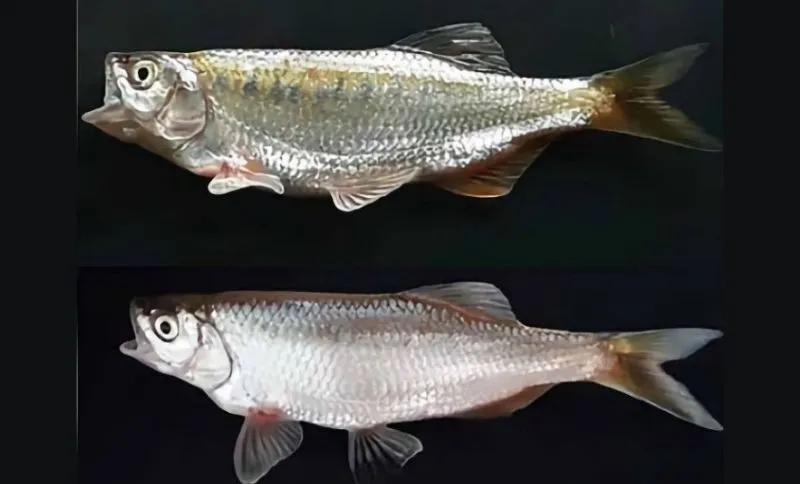New fish species Barilius imphalensis: The New ‘Ngawa’ of Imphal River
Short Summary
In early July 2025, researchers L. Arunkumar and M. Thoibi from Mayai Lambi College, Imphal West, officially documented a brand-new freshwater fish species, Barilius imphalensis, in the Imphal River’s Khongnang Pheidekpi area. Locally called “Ngawa” in Meitei, this danionid fish stands out due to its lack of barbels, short vertical blue stripes, 41-scale lateral line, and distinctive male tubercles on snout and jaw. The discovery, published in Zoodiversity, highlights the rich, endemic biodiversity of Manipur’s aquatic ecosystems and raises fresh conservation interest
Introduction – A Fishy Surprise in Manipur
Ever wondered if there’s still surprise left in our own backyards? Well, bet your boots on it. Meet Barilius imphalensis, the shiny new resident of the Imphal River that just burst onto the scientific scene. Found in the Khongnang Pheidekpi streams, this fresh-faced fish isn’t just another darting blur in the water—it’s a headline grabber, cake topper, and conservation symbol rolled into one.
1. Where in the River Did Barilius imphalensis Emerge?
The story begins in Khongnang Pheidekpi, tucked within Imphal West. Researchers from Mayai Lambi College spotted this divergent little fish in shallow, clear stream pools—roughly 3 to 5 feet deep—with a gravelly riverbed and riverbank greenery like Erianthus procerus and Saccharum munja
This spot is now dubbed the “type locality”, meaning it’s the official birthplace of Barilius imphalensis in the eyes of science. It’s part of the Chindwin River network, a freshwater labyrinth flowing through ancient hills and vibrant cultures.
2. The Fish That Stands Apart: Key Characteristics
From the get-go, Barilius imphalensis flips the script on typical Barilius traits. Let’s break down its standout features:
No Barbels, No Problem
Barilius imphalensis rocks its fins without barbels—those whisker-like feelers most danios sport. That’s a big clue, folks, flagging its unique classification .
Blue-Striped Fashion Statement
This fish is draped in a series of short blue vertical bars—between 15 and 17—that pop on its sleek body. Think of it as nature’s barcode, exclusive to Imphal’s streams
Lining Up with 41 Scales
Its lateral line (think of an underwater heart monitor) is meticulously complete with 41 scales, offering a strong fingerprint against relatives
Male Tubercle Traits
Male fish flash tiny tubercles—little bumps—on their snouts and jaws. Females? Nada. Sexual dimorphism at play, giving researchers another clue to separate sexes
Proportional Precision
Our finned friend has precise body measurements: body depth, fin heights, eye size—all consistent with a tight species formula outlined in Zoodiversity
3. Why This Discovery Matters—Big Time
Biodiversity Boost
Each new species is like discovering a novel word in nature’s dictionary. Having a species unique to the Imphal River boosts our understanding of biodiversity in northeast India—even globally.
Conservation Clues
When a species is endemic—living nowhere else—conservation stakes rise sharply. Locals, scientists, policymakers can now spotlight Imphal’s freshwater zones as conservation priorities.
Cultural Connection
Locally, it’s called “Ngawa”—a name shared by other hill-stream Barilius species. Now the term gains cultural depth, uniting scientific and traditional naming in Meitei heritage.
Science Power
Finding a new fish tests our classification systems and refines taxonomic keys (like detective charts for fish species). It could even lead to discoveries of more elusive Imphal creatures.
4. What’s Life Like for Barilius imphalensis?
Let’s go on a day-in-the-life tour with our striped swimmer.
Habitat Highlights
- Depth: shallow pools of 3–5 ft
- Bed: gravel, cobbles—perfect for spawning and hiding
- Veggies: grass-like stream-edge plants feed small insects for food
Behavior Guesswork
Though direct observations are pending, we can infer from similar Barilius:
- Strong swimmers: dart and flick around cobbles
- Diet: insect lovers—larvae, small bugs amidst the pebbles
- Social: they likely hang in schools, a safe-system against predators
5. Barilius Neighbors: What Else Lives Here?
“Ngawa” in Meitei refers to multiple Barilius types—like B. barila, B. barna, B. bendelisis—common in regional hill streams
Still, the tags matter—B. imphalensis:
- No barbels, unlike some
- Blue bar count, a distinct signature
- 41-scale lateral line, not 35 or 37
The newly created identification key for north-east Barilius species makes life easier for fisheries and field biologists
6. Naming the Fish: Barilius imphalensis
The species name “imphalensis” means “from Imphal”, tying it firmly to its birthplace . This naming tradition keeps the fish’s story tied to its home river.
Conclusion – A Ripple Effect
Barilius imphalensis reminds us that extraordinary wonders still swim in local streams. Its discovery is a wake-up call to celebrate biodiversity, champion conservation, and embed nature into culture and education.
This new species isn’t just another fish. It’s a conversation starter, habitat ambassador, and symbol of what Manipur’s freshwaters still have in store.
FAQs
1. How is Barilius imphalensis different from other Ngawa fish?
It lacks barbels, has 15–17 distinct short blue bars, sports 41 scales along its lateral line, and males sport snout/jaw tubercles – a unique combo
2. Where exactly was it found?
In the Khongnang-Pheidekpi area of Imphal West, in shallow Imphal River pools (3–5 ft deep) with gravel and streamside vegetation
3. Why is it important to protect this fish?
As an endemic species, its existence is tied to river health. Protecting it safeguards its future—and the wider aquatic ecosystem.
4. Can I see one while in Manipur?
Possibly! Local eco-guides or researchers might show you its habitat. Just stay respectful, don’t disturb, and try citizen science.
5. What conservation steps are essential now?
Key steps include legal protection, population surveys, community education, regular monitoring, and citizen science initiatives.




